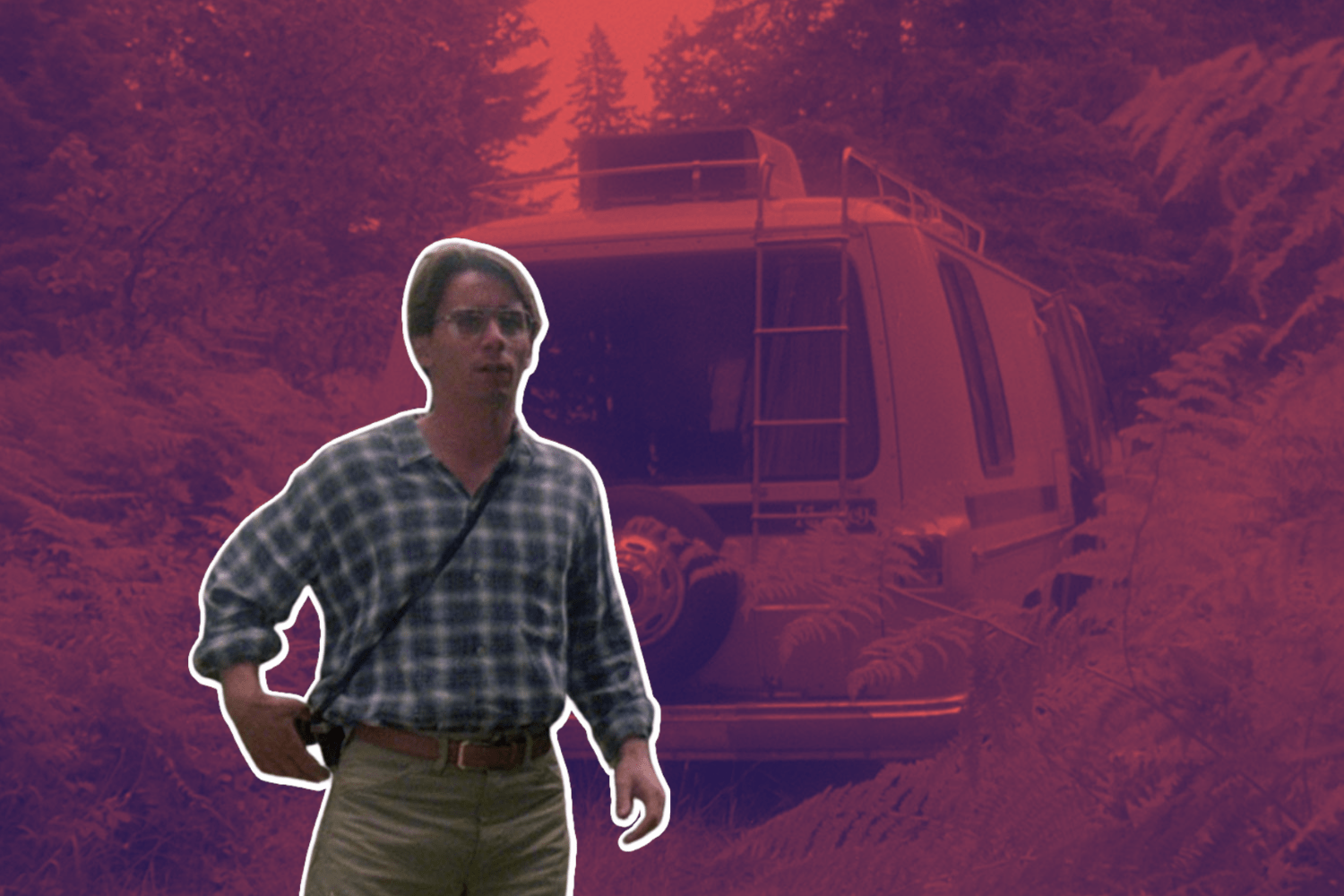Editorials
The Abysmal Magnetism of ‘Just Before Dawn’
December 13th, 2021 | By RC Jara

Want to dig into your favorite filmmakers’ favorite horror films? Look no further than 1981. The horror landscape of that year was eclectic, with strong representation for slashers in particular. But even in a competitive field, Jeff Lieberman’s Just Before Dawn has emerged as one of 1981’s most notable slashers. The title evokes feelings of serenity more than terror, but don’t expect anything tame. Leberman is here to unleash the hounds.
It’s important to remember how often horror uses the cover of darkness to hide its monsters. Here, Lieberman lets the day break over his audience with the dread-inducing accompaniment of Brad Fiedel’s synth score. Nestled underneath is a kind of atonal whistle (not unlike the hate motif that opens West Side Story). Instead of overcoming the rigidity of your immediate social programming, this call entices a feral impulse. It teases the viewer. By the end, the connotation of a calming, peaceful moment before sunrise turns into something much more sinister.
Lieberman leaves little to the imagination when we meet the first of our killers. And really, what is a slasher without its opening kill? In many cases throughout the ‘80s, this is the scene that either establishes or continues a series tradition by lovingly blending lore with gore. In Just Before Dawn, two men giddily discuss hunting a buck before turning into prey themselves. The killer watches them through a hole in the ceiling of a decrepit chapel. His face is dirty and he’s built like the mountains that provide scenery. He locks eyes with one of the men as he mercilessly brings his wrath on them. There is not a single deity or piece of technology that they can rely on for salvation. Lieberman leans hard on religious pessimism in a movie about inbred psychopaths.
When we first hear the call from the mountain, it feels as though the land itself is making the sound. When we meet our cast of unlucky campers, they pass through the environment as disrespectfully as one would expect. Ogling at a pair of destitute children (twins) like a zoo exhibit and mindlessly throwing whole food items out of the window of their van. There’s no penalty for rooting against them from the minute they appear.
Upon realizing how much of a nuisance these people are, park ranger Roy McLean (George Kennedy) confronts Warren (George Henry), the so-called “owner” of a sizable piece of land deep in the mountains. During this exchange, Warren smugly brandishes a deed from his lawyer to an exasperated McLean. The campers attempt to slyly mislead the ranger so as to not get any surprise visits. But McLean knows that, killer or not, these kids aren’t built for any sort of living out in the wilderness.
The film’s cinematography is a constant, humbling reminder of how out-of-place some characters are in the outdoors. Just Before Dawn may have been buried alongside other woodsy slasher pics, but it is the strongest for how its themes motivate the image. As the campers traverse the mountain, up roads and across rope bridges, Dean and Joel King’s photography engulfs them in greenery. The tone at any given moment in the film is threatening. However there are times when even the characters stop to marvel at the untouched beauty around them. Warren’s girlfriend Connie (Deborah Benson) is particularly mesmerized. They acknowledge the contradiction of owning any part of the land before Warren laughs off the challenge. His confidently sheltered outlook on life proves deadly.
Speaking to that point, Just Before Dawn observes the time-honored slasher tradition of goofy white people dancing to muzak before getting their asses handed to them. Though despite how mean-spirited this film is, Lieberman certainly knows how to shift the balance between stone-cold dread and humor. It boasts the karmic resonance of ‘70s horror, films where a group of self-centered characters find out just how badly the universe has it out for them. One character, Jonathan (Chris Lemmon), is slashed by one of the Mountain Twins and narrowly escapes falling to his death after the killer cuts the rope bridge. A close up of Jonathan shows us the haggard man able to climb up the other side, only to be met by the second killer. He is kicked in the face and sent tumbling to his doom. Towards the end of the film his body washes up in a creek where Connie and Warren are playing with a fish.
Many characters in Just Before Dawn share a similar fate. And on first watch, it’s uncanny how closely the film’s rhythms match several of its contemporaries. Yet it isn’t the midwestern romp of Don’t Go In The Woods. Nor does it engage in moralistic drama like The Burning. There’s a line about a summer camp that hits a little too close to be coincidental. But death in this film is more than just about putting people down. The evil in mountains, and it’s influence, is mythological. This film’s equivalent to Friday the 13th’s Crazy Ralph goes mad in the face of “the demons” that dwell there. His psychosis is part trauma, part realization that the abject horrors of the wild are no match for civilization. It’s curious how Lieberman drives this point literally from the destruction of vehicles and food items, to the image of the rotting chapel that is used in its scariest sequences. Even something as simple as a whistle, which Jonathan carries with him as a gag, only to need it later, is a tool that produces a weak sound compared to the animalistic call.
Caught up in this breakdown of earthly possessions that the group rely on for survival is a make-up kit. When we meet the cultish family of the mountains we see that one of the daughters, Merry Cat Logan (Katie Powell), fixates on the cosmetics. She doesn’t know how to apply any of what she’s using, but her intentions are clear. There is a yearning for a life outside of the wilderness. For a moment, she takes on the role of Ruby in The Hills Have Eyes. Merry Cat sympathizes with the young people her family is hunting. Lieberman seems to set this up as a noble—if thematically naive—story progression, even if he is not overly concerned with setting these matters neatly.
The significance of the make-up box is one of the film’s strongest visual metaphors. It is played for laughs when one of the women in the group, Megan (Jamie Rose), becomes visibly upset after it is taken from her. Merry Cat sees Megan and Connie as examples she hopes to emulate. The film’s awareness of psychosexual qualities in the nascent slasher genre is not lost in this dynamic. Interestingly, it is mainly Merry Cat who assumes the role of voyeur whenever sexual situations arise. She is a substitute for the plotting gaze, usually a male killer. For her, the idea of make-up being an affirmation of womanhood and civility is briefly entertained. Regardless, Connie takes center stage as the film’s protagonist once bodies start to drop. This trip has awakened her to the possibilities of wielding power in both worlds.
For the majority of the runtime, Connie puts up with Warren’s denial of the severity of what is happening around them. Benson plays the character as disconnected from her body yet eerily perceptive. Through her, as it does through its landscape photography, the film explores the esoteric nature of the mountain. We watch Connie listen offscreen for the animalistic call and become entranced by the fireside. She quietly gathers information as we parse through how, if at all, there will be any survivors. One of the killers is shot in the head and falls directly on top of her. This is a catalyst for Connie to take control of her own fate while Warren cowers nearby.
When the moment presents itself, Connie lures the second killer out of the forest. Similar to how Amy Steel throws on Mrs. Voorhees’ sweater to trick Jason, Connie fixes her face. The warmth of motherhood and the promise of sexual gratification are unnervingly one in the same in both films. After a brief struggle, she chokes the Mountain Twin to death and scares Merry Cat away. Here, the film’s examination of duality comes full-circle. It ends as Connie discovers how to channel savagery through civil means. Lieberman and his writing team may have given evil a physical form, but this ending feeds on the ambiguity of evil as an indestructible force. One that nobody is impervious to, should they stick around long enough to answer its call.
Aside from some surface similarities, the deluge of 1981 slasher films had one important thing in common: negative critical reception. If you only experienced slashers through consumer guides, your impression would be that they are unscary, dismal rip-offs. Hedonistic works of cultural terrorism measured in “m.p.g.p (murders per gallon of popcorn).” Dominant reactions like that is why it has been heartening to see a renewed cultural appreciation for all the gutter of slasher cinema offers. And in such a busy year, it is unsurprising that non-franchise entries slipped through the cracks. Let alone one as understated as Just Before Dawn. I am thankful this film found its way to me. Even (or especially) if it forces me to consider the fragility of my social surroundings.
Visit our Editorials page for more articles like this. Ready to support more original horror criticism? Join the Certified Forgotten Patreon community today.


